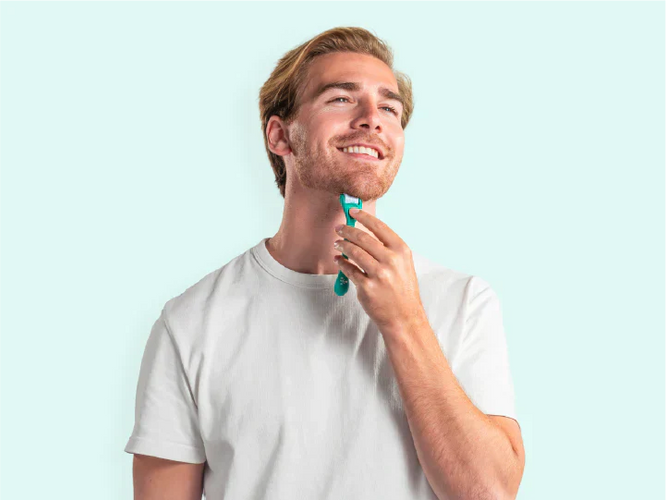A common problem when growing a beard, is patchy beard growth on the cheeks. Many men experience thicker hair around their upper lip and mouth. If your goal is to achieve a full beard, this article helps you to understand how you can grow hair on your cheeks. For example, through using beard growth products that effectively stimulate hair growth on your beard line.

How can I Grow beard on my cheeks?
Your ability to grow facial hair is largely determined by genetic factors, not by testosterone. Only if you have clinically low levels of testosterone, you can experience patchy beard growth. Your body uses an enzyme called 5-alpha reductase to convert testosterone into dihydrotestosterone (DHT). DHT binds with receptors on your facial hair follicles to stimulate hair growth. The sensitivity of DHT is determined by genetics.
The best strategy to grow a beard on the cheeks works as follows:
- Grow out your beard: Letting your beard grow out can hide spots where your facial hair grows sparsely.
- Try microneedling: Using a beard growth-enhancing roller for pricking your face with a series of tiny needles can help your hair grow and increase blood flow. Research has found that it is effective for stimulating hair growth to tackle male pattern baldness and stimulate beard growth if you combine it with an effective beard serum.
- Take care of your health: Eat a balanced diet, avoid smoking, limit alcohol, and exercise regularly to potentially improve your skin and hair health on the beard line.
- Proper skin care: Maintaining a skincare routine that caters specifically to the facial skin under the beard is crucial. Regular cleansing, moisturizing, and exfoliating help keep the skin beneath the beard healthy, fostering a conducive environment for hair growth.
- Use of Beard serum/oils: Incorporating beard serums or oils enriched with essential nutrients can nourish the facial hair follicles and moisturize the skin. These products can promote healthier, stronger hair growth and prevent dryness or irritation in the beard area.
- Avoid frequent shaving: Limiting the frequency of shaving allows the beard hair to grow without interference. Continuous shaving can sometimes lead to skin irritation and hinder the natural growth process, so allowing periods of growth can support fuller beard development.
What age does beard grow on cheeks?
The rate that your beard grows is as already said determined by genetics. The rate of growth widely varies between people, and there haven’t been many studies looking at the average rate of beard growth by age. However, many people report their beard growing around ½ an inch per month. To grow a short beard on your cheeks will likely take at least a month when you are above the age of 18.
What factors hinder beard growth?
Factors that can contribute to the appearance of your facial, which are not caused by genetics are:
- Alopecia areata: This autoimmune disorder targets hair follicles, resulting in patchy hair loss on the head and beard. There is no effective treatment against alopecia areata, but Neoxyl® a hair growth complex may help to regrow hairs.
- Low testosterone: Clinically low testosterone levels can contribute to hair loss but are often not the only cause. Low testosterone also contributes to less beard growth and patchy beard growth.
- Age: Many men observe their beards becoming denser in their 30s, so you don’t have to be insecure when your hair does not grow as fast as you want.
- Nutrient deficiencies: Inadequate intake of essential minerals or vitamins can potentially limit beard growth. Extremely low levels of protein, for example, can disrupt beard growth.
Myths About Beard Growth
There are many myths on the internet about growing facial hair, including on your cheeks. Here are some common myths that you may hear:
- Shaving makes your beard thicker: You may have heard that shaving your facial hair makes it grow back thicker on your cheeks. However, shaving your beard has no effect on beard growth.
- More testosterone leads to a thicker beard: While extremely low levels of testosterone may inhibit beard growth, unless your testosterone levels are clinically low, they probably aren't affecting your beard growth.
Conclusion
Growing a beard on your cheeks and achieving a fuller-looking beard is primarily determined by your genetics. It's essential to understand that not being able to grow a beard on your cheeks doesn't pose health risks, provided you are otherwise healthy. When you experience a difficulty in growing a beard on the cheeks, than remember beard growth products can stimulate your hair growth!










